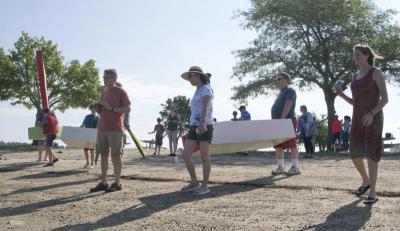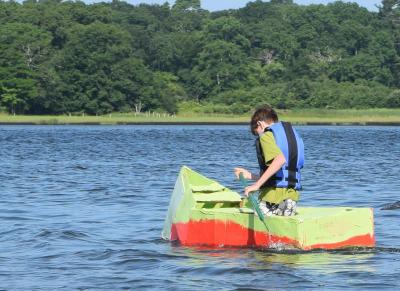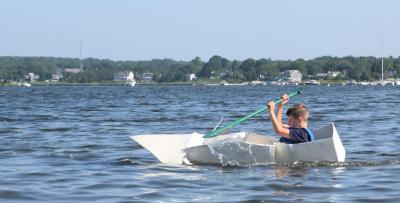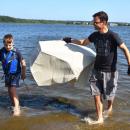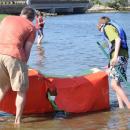Cardboard canoers take on Apponagansett Bay
When Asher Pinkerton entered the waters of Apponagansett Bay aboard his canoe — called the USS Tiny — it quickly became apparent it was too tiny.
The 12-year-old built the canoe himself out of cardboard and a small, limited list of other supplies as part of a week-long Friends Academy summer camp program.
“I designed it small so I could turn it better,” Pinkerton said after emerging from the water during a test sail on July 13. “It ended up being too small.”
The size adversely affected his ability to paddle, because it was too small for him to move around in and effectively steer the boat.
Throughout the week, the fourth through ninth graders worked on boat designs with Dartmouth High teacher Samuel Brodsky. They could only use the supplies Brodsky provided: Cardboard, paper tape, wood glue, and latex paint.
Students first created models and then tested their designs in the classroom before building the final design.
Erick Dawson, 12, didn’t get too far on his cardboard canoe. When he first entered the water, a design flaw became apparent: He didn’t use enough support.
Lowell Copps, 12, did use enough support for his boat overall, but missed one critical spot: Where he would be sitting.
“I was kneeling down to paddle and my knees made a hole,” Copps said.
If he were to design a cardboard canoe again, he agreed he’d add a lot more support to the sitting area.
Not everyone faced flooding. Sofia Mateo, 10, of Dartmouth, based her cardboard canoe on a traditional sailboat design, including a mast to guide the canoe. She used her cardboard to support the sides of the boat.
“It worked really good, and I barely got any water in it,” Mateo said.
Her design was not without one problem though: It was difficult to sail. She had to fight against the wind to get her canoe out of a circular motion.
Ten-year-old Aiden Durant skimped on the side supports, but that didn’t cripple his boat. Instead, the bow raised and allowed him to set sail.
“It was hard to steer through,” he said, noting in the future he’d use more side supports.
As students collected their soggy cardboard boats, Brodsky noted that’s what it’s all about: Testing, failing, and brainstorming what to do differently.
“It was great to see their design process and finally testing it for real,” Brodsky said.





